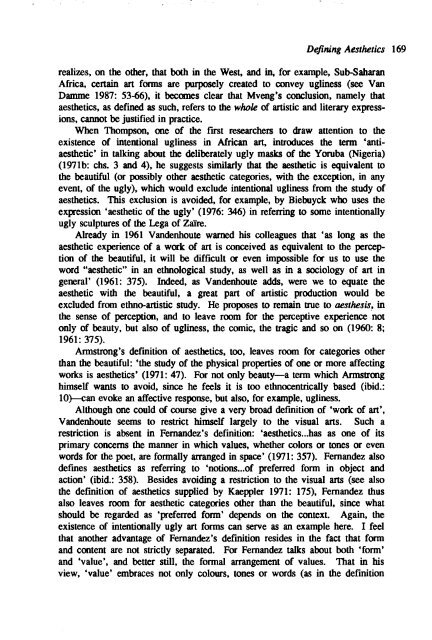1991 No. 1 CONTENTS - Institute of Social and Cultural ...
1991 No. 1 CONTENTS - Institute of Social and Cultural ...
1991 No. 1 CONTENTS - Institute of Social and Cultural ...
Create successful ePaper yourself
Turn your PDF publications into a flip-book with our unique Google optimized e-Paper software.
Defining Aesthetics 169<br />
realizes, on the other, that both in the West, <strong>and</strong> in, for example, Sub-Sabaran<br />
Africa, certain art forms are purposely created to convey ugliness (see Van<br />
Damme 1987: 53-66), it becomes clear that Mveng's conclusion, namely that<br />
aesthetics, as defined as such, refers to the whole <strong>of</strong> artistic <strong>and</strong> literary expressions,<br />
cannot be justified in practice.<br />
When Thompson, one <strong>of</strong> the fU'St researchers to draw attention to the<br />
existence <strong>of</strong> intentional ugliness in African art, introduces the term 'antiaesthetic'<br />
in talking about the deliberately ugly masks <strong>of</strong> the Yoruba (Nigeria)<br />
(1971b: chs. 3 <strong>and</strong> 4), he suggests similarly that the aesthetic is equivalent to<br />
the beautiful (or possibly other aesthetic categories, with the exception, in any<br />
event, <strong>of</strong> the ugly), which would exclude intentional ugliness from the study <strong>of</strong><br />
aesthetics. This exclusion is avoided, for example, by Biebuyck who uses the<br />
expression 'aesthetic <strong>of</strong> the ugly' (1976: 346) in referring to some intentionally<br />
ugly sculptures <strong>of</strong> the Lega <strong>of</strong> Zaire.<br />
Already in 1961 V<strong>and</strong>enhoute warned his colleagues that 'as long as the<br />
aesthetic experience <strong>of</strong> a work <strong>of</strong> art is conceived as equivalent to the perception<br />
<strong>of</strong> the beautiful, it will be difficult or even impossible for us to use the<br />
word "aesthetic" in an ethnological study, as well as in a sociology <strong>of</strong> art in<br />
general' (1961: 375). Indeed, as V<strong>and</strong>enhoute adds, were we to equate the<br />
aesthetic with the beautiful, a great part <strong>of</strong> artistic production would be<br />
excluded from ethno-artistic study. He proposes to remain we to aesthesis=, in<br />
the sense <strong>of</strong> perception, <strong>and</strong> to leave room for the perceptive experience not<br />
only <strong>of</strong> beauty, but also <strong>of</strong> ugliness, the comic, the tragic <strong>and</strong> so on (1960: 8;<br />
1961: 375).<br />
Annstrong's definition <strong>of</strong> aesthetics, too, leaves room for categories other<br />
than the beautiful: 'the study <strong>of</strong> the physical properties <strong>of</strong> one or more affecting<br />
works is aesthetics' (1971: 47). For not only beauty-a term which Armstrong<br />
himself wants to avoid, since he feels it is too ethnocentrically based (ibid.:<br />
10}--can evoke an affective response, but also, for example, ugliness.<br />
Although one could <strong>of</strong> course give a very broad defmition <strong>of</strong> 'work <strong>of</strong> art',<br />
V<strong>and</strong>enhoute seems to restrict himself largely to the visual arts. Such a<br />
restriction is absent in Fem<strong>and</strong>ez's defmition: 'aesthetics... has as one <strong>of</strong> its<br />
primary concerns the manner in which values, whether colors or tones or even<br />
words for the poet, are formally arranged in space' (I 971: 357). Fem<strong>and</strong>ez also<br />
defmes aesthetics as referring to 'notions... <strong>of</strong> preferred form in object <strong>and</strong><br />
action' (ibid.: 358). Besides avoiding a restriction to the visual arts (see also<br />
the defmition <strong>of</strong> aesthetics supplied by Kaeppler 1971: 175), Fem<strong>and</strong>ez thus<br />
also leaves room for aesthetic categories other than the beautiful, since what<br />
should be regarded as 'preferred form' d~pends on the context. Again, the<br />
existence <strong>of</strong> intentionally ugly art forms can serve as an example here. I feel<br />
that another advantage <strong>of</strong> Fem<strong>and</strong>ez's defmition resides in the fact that form<br />
<strong>and</strong> content are not strictly separated. For Fem<strong>and</strong>ez talks about both 'form'<br />
<strong>and</strong> 'value', <strong>and</strong> better still, the formal arrangement <strong>of</strong> values. That in his<br />
view, 'value' embraces not only colours, tones or words (as in the defmition
















